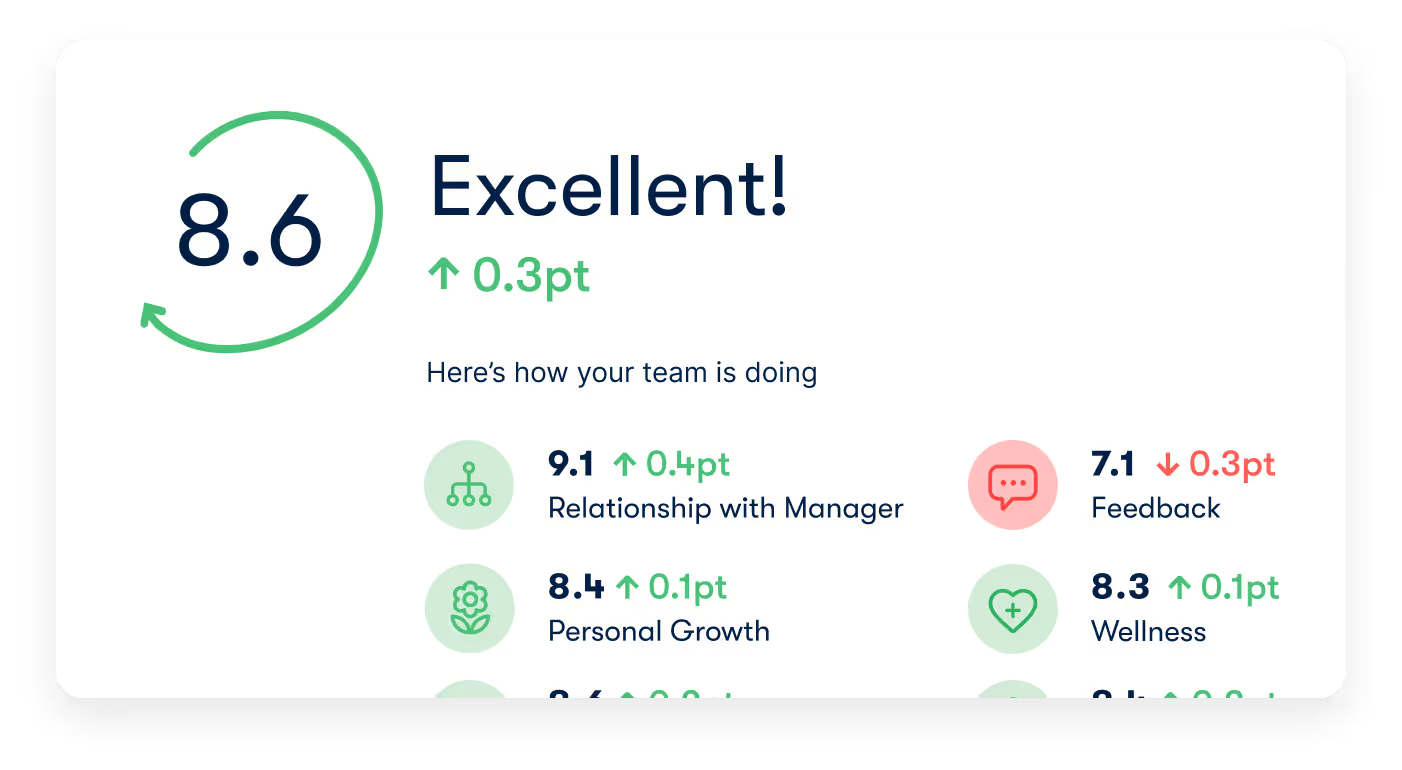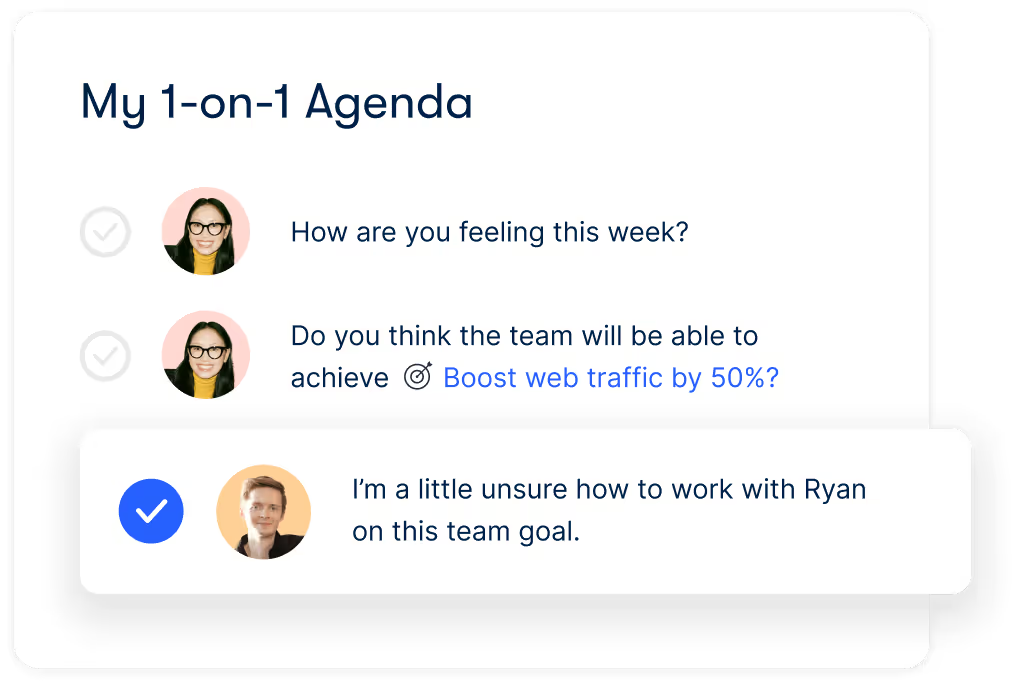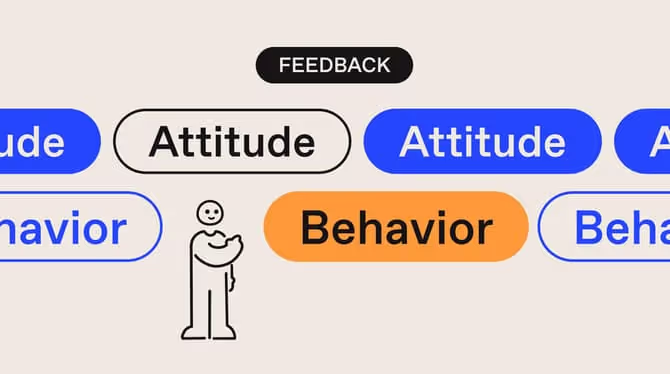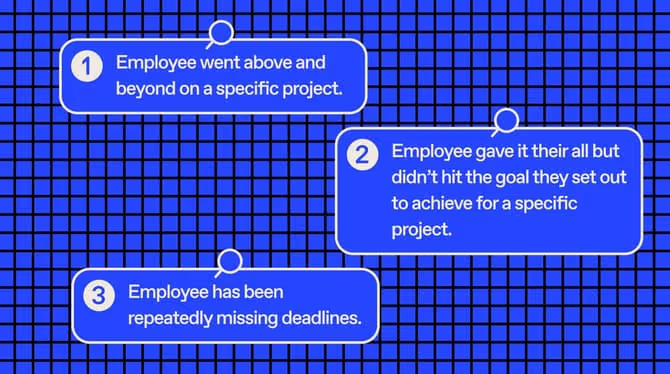How to give negative feedback without demotivating employees

Discover Workleap Officevibe's benchmark report on 12 key employee engagement metrics

In every leader’s career there comes a time when they have to give negative feedback to a direct report. Someone might be underperforming, having interpersonal issues with another team member, or feeling disengaged from their work. These are the moments where you need to step up and offer honest feedback to try to help the situation. But it’s not always clear how to best give tough feedback in a way that lands with the recipient. In fact,
The way you give feedback can have a big impact on an employee’s success, engagement, and level of trust toward you — for better or for worse. This is why giving feedback effectively is an important skill for leaders to develop.
Keep reading for tips on how to improve your feedback skills, create a feedback culture on your team, and make constructive criticism a positive experience for your team members.
Why knowing how to give negative feedback is so important?
It can be as tough giving negative feedback as it is to hear it. But the reason why it’s challenging to give is the same reason why it’s so important that you do: because you care about the person you’re sharing feedback with. Offering constructive feedback to employees shows that you’re invested in their progression and achievement.
{emphasize}
Think about it this way: If you were doing something that interfered with your team’s success (or your own), wouldn’t you want someone to tell you, and help you correct it?
{emphasize}
The point of giving negative feedback isn’t to shine a light on a mistake or failure. Constructive criticism should show someone another perspective or highlight something they weren’t aware of. The intention should be to help, not to reprimand.
Learning is the bottom line of all types of feedback. Whether it’s positive feedback or negative feedback, it should always be constructive. Ongoing development and opportunities for growth are among the most important factors for job satisfaction. So having a manager who’s good at delivering negative feedback can make a big difference in an employee’s experience, not to mention their performance.
How to give negative feedback effectively: 5 tips
Even with strong communication skills and a healthy level of trust, delivering negative feedback is never easy. It’s normal to feel nervous and wonder what will happen and how your employee will receive your feedback. What if they get angry? Cry? Don’t like me? What if they quit?
Remember that you have a lot more control over how you deliver negative feedback than how it’s received. If you’re prepared, it makes your feedback process a lot less stressful and leads to a more productive conversation.
{emphasize}
Use these tips on how to give better feedback to walk into your next feedback session calm and collected.
{emphasize}
1. Prepare your talking points
It’s always important to plan out what you want to say and how you’ll say it. This helps you stick to the main points you want to address and make sure your negative feedback is delivered properly. If you can, try bouncing your notes off a trusted colleague or friend for an outside perspective on how your feedback comes across.
{emphasize}
Questions to help you prepare:
- Have I covered the who, what, where, when, and why of the situation?
- Am I naming a specific behavior and/or giving specific, concrete examples?
- What are the 2-3 most important points I want to express in my negative feedback?
- Do I have next steps in mind for myself or the other person?
- What are my intentions in sharing this feedback?
{emphasize}
That last question is one of the most important. Understanding your intentions helps you measure the success of your feedback session and pinpoint a goal for the conversation.
{emphasize}
A positive intention is a good intention: Giving negative feedback isn’t about proving a point or punishing someone. Whether it’s to improve performance, address disengagement, or manage peer relationships, your intentions should always be positive.
{emphasize}
2. Keep it professional, avoid getting personal
Negative feedback should never be directed at an employee’s personality — it should be about their actions or behavior, both of which are amenable. Corrective feedback at work needs to be related to the person’s role, responsibilities, or otherwise relevant to the job. And, negative feedback should improve team and employee performance.
{emphasize}
Pro tip: While you shouldn’t make it personal about them, negative feedback should be personal coming from you. Use openers like “I think / I feel / I wonder if…” instead of offering negative feedback from a general perspective, like “You are / You do…”
{emphasize}
{emphasize}
Specific examples of professional negative feedback:
- Instead of: You’re too slow and you’re not keeping up with your peers.
Try saying: I noticed you were struggling to meet your deadline last week, let’s talk about what was blocking you. - Instead of: You said "like" and "um" every other word during your presentation and it was really unprofessional.
Try saying: The content of your presentation was excellent, and I have a few pointers for a more impactful delivery if you’re open to my feedback.
Like these examples? Discover even more employee feedback examples to help you formulate your thoughts like a pro.
{emphasize}
3. Ask questions and listen carefully
Every productive conversation is a two-way street. Sometimes a good way to approach tough feedback is to start by asking for the other person’s perspective. You can ask coaching questions to help guide them through the issue at hand and arrive at their own conclusions. Hear them out on their theories of what could be done better — you might even be surprised by their insights.
{emphasize}
Try the past-present-future method:
- How do you think things are going right now with [name the topic of discussion]?
- Have you ever had issues like this in the past? How did you deal with them?
- Do you have ideas for how we can improve the current situation or avoid it in the future?
{emphasize}
4. Be direct and genuine
Have you ever tried to deliver feedback using the sandwich method? In other words, squishing the negative feedback between two positives in the hopes of softening the blow? This is a surefire way to confuse your receiver and dilute your message. Keep positive feedback separate from constructive feedback to avoid sending mixed messages.
Likewise, if you try to mask your criticism as positive feedback, or suddenly take on a new persona in your feedback session, your direct report might start to feel distrustful or defensive. Employees want a manager who’s honest, transparent, and communicative. So be natural, be direct, and keep your employee’s best interest in mind when you share negative feedback.
{emphasize}
3 quick tips for more authentic exchanges:
- Check in on your mindset: Are you feeling frustrated, upset, or judgmental? Maybe even just tired, stressed, or distracted?
- Exercise your empathy: If you were the one receiving feedback, how would you want someone to share their thoughts with you?
- Stay true to the relationship: Avoid taking on a more professional or personal tone than usual. Approach the conversation how you would in any other one-on-one with this person.
{emphasize}
5. Discuss solutions and set next steps
Giving constructive feedback isn’t just about evaluating, it’s about evolution. Ongoing feedback is a crucial part of improving and managing employee performance and helping your team members grow. So beyond sharing your perspective on the present, be sure to discuss how the feedback applies in the future, and what actions your employee might take to apply it in their day-to-day.
{emphasize}
Try the problem-implication-solution approach:
- Problem: Raise the issue at hand and present the facts.
- Implications: Discuss how it affects the team, project, or company.
- Solutions: Workshop ways to resolve the situation together and decide on a few that make sense.
{emphasize}
Whatever the starting point of the conversation, an important part of giving corrective feedback is establishing clear next steps. Help your employee pinpoint a few action items you can follow up on in your next discussion.
What are the effects of poorly delivered negative feedback?
Poorly delivered negative feedback can be worse than no feedback at all. How people receive feedback can make a big difference in how (or whether) they apply it. If constructive feedback is perceived as criticism, punishment, or an attack, employees may shut down. This can impact everything from an employee’s performance to their morale, engagement, and trust in their manager or peers.
{emphasize}
According to Officevibe’s Pulse Survey data, employees who say the feedback they get at work doesn’t help them grow and develop also tend to feel:
- Dissatisfied working with their direct manager.
- That they’re not appropriately involved in decisions that affect their work.
- Unlikely to call their company a great place to work.
- That communications among peers lack transparency.
- Like they’re not a part of a team.
{emphasize}

Giving negative feedback in a one-on-one meeting
A one-on-one meeting is often the best setting for giving negative feedback to an employee. Critical feedback can be tough to hear, and the most respectful way to bring up any kind of constructive criticism is in a private conversation.
How to give constructive feedback in a one-on-one
- Schedule the meeting in advance. Avoid catching your direct report by surprise by sending them a meeting invite.
- Set a meeting agenda and talking points. In your invitation, include a brief agenda of the points you’d like to discuss — our meeting agenda template for difficult conversations can come in handy. Ask your employee to add anything they’d like to go over, too.
- Give the employee space to talk. Keep an open mind and ask plenty of one-on-one meeting questions, to prompt your employee to reflect and share.
- Take notes and set action items. Write down notes on what you’ve discussed, and go over any action items you set at the end of the feedback session.
- Don’t forget to follow up. Check in with your employee at your next one-on-one, or even beforehand, to see how they’re processing and implementing your feedback.

Make ongoing feedback a part of your employee management
When regular feedback exchanges are a part of your manager-employee relationships, it makes it a lot easier to offer negative feedback when you have to. Not only does getting more practice make giving feedback less intimidating, it also helps employees be more open to hearing you out. Keep a regular feedback frequency to avoid catching anyone off guard, and definitely don’t stockpile negative feedback and dump it on someone all at once.
Beyond simply giving feedback more frequently, you also need to be asking for it. If employees know that they can share their thoughts and opinions with you, they’ll be more receptive when you share feedback with them. This is why developing feedback loops and getting feedback from employees is so important.
How to build a feedback loop on your team
- Be open to receiving feedback: Ask for your direct reports’ opinions and share the things you’re working on personally. Demonstrate that everyone has room to grow and set the tone for ongoing professional development. See our examples of manager feedback.
- Solicit employee feedback: An anonymous employee feedback tool like Officevibe gives people the space to share their honest thoughts, ideas, questions, or concerns. It sparks conversations that wouldn’t happen otherwise.
- Put feedback into practice: Apply the insights you gather from employees into the day-to-day functioning of the team. When people see that you accept feedback openly, they’ll be more likely to do the same.
- Get your team members involved: Involve employees in the ongoing development of work processes and ask for their ideas on how you can improve as a team. Make it clear that everyone’s voice counts.

Providing feedback is at the heart of great leadership
It might be challenging, but offering feedback is a part of people management — and that includes the occasional constructive criticism. When you’re committed to employee development, the person receiving your feedback will see that you’re coming from a good place.
Use the tips outlined in this article to give tough feedback in a more constructive way.
Give HR and managers the clarity, confidence, and connection to lead better every day.


%20(1).avif)


.avif)
.avif)








.avif)